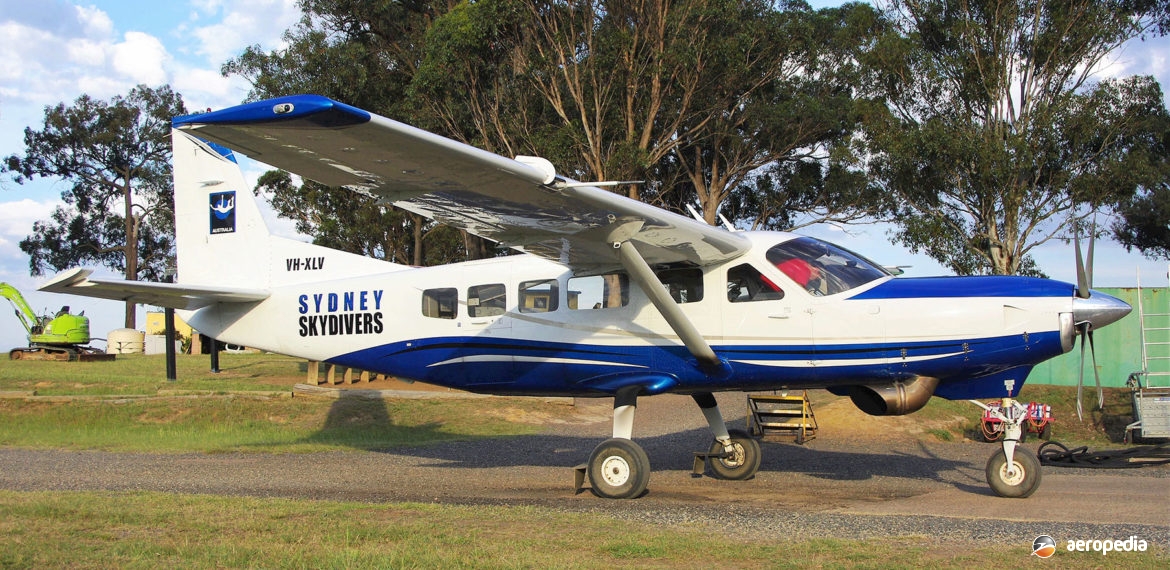Photograph:
Texas Turbine Conversions 208B Caravan VH-XLV (c/n 20800053) at Wilton, NSW in October 2011 (David C Eyre)
Country of origin:
United States of America
Description:
Commercial transport
Power Plant:
One 671 kw (900 shp) Honeywell TPE-331-12JR turboprop
Specifications:
- Wingspan: 15.88 m (52 ft 1 in)
- Length: 12.68 m (41 ft 7 in)
- Height: 4.72 m (15 ft 6 in)
- Wing area: 26 m² (280 sq ft)
- Max cruising speed: 367 km/h (228 mph)
- Stalling speed with flaps: 113 km/h (70 mph)
- Endurance: 6.2 hours
- Range at max cruising speed with standard fuel: 1,852 km (1,151 miles)
- Take-off roll: 321 m (1,054 ft)
- Take-off over 15 m (50 ft) obstacle: 571 m (1,875 ft)
- Landing roll: 290 m (950 ft)
- Ceiling: 10,668 m (35,000 ft)
- Empty weight: 2,221 kg (4,675 lb)
- Useful load: 1,990 kg (4,387 lb)
- Loaded weight: 4,110 kg (9,062 lb)
History:
In the United States a number of conversions have been made to aircraft to change engines and increase performance. One company carrying out this type of conversion was Texas Turbine Conversions which converted de Havilland Otters to turbine power, and fitted Honeywell TPE-331 turboprops to Cessna 208 and 208B Caravans in place of the Pratt & Whitney PT-6. The Company chose the TPE-331 for superior fuel specifics, faster power response, higher base time between overhaul, and lower operating costs per horsepower. Take-off distance and distance to clear a 15 m (50 ft) obstacle decreased by about 25 to 30 per cent; and cruising speed increased by 46 km/h (29 mph) to 74 km/h (46 mph). Power provided was 674 kw (1,000 shp) de-rated to 607 kw (900 shp) driving through a direct drive four-blade Hartzell propeller.
The first example of this model seen in this area was N832SA (c/n 832). Described as a Super Cargomaster, this aircraft was ferried to New Zealand where it became ZK-KPH (c/n 208B0832) at its base at Queenstown in November 2010 operating with Skydive Queenstown.
A further example was imported to Australia. This aircraft VH-XLV (c/n 20800053 – ex N9438F) was first registered to Hermens Markar Express Inc but crashed at Bethel, Alaska on 19 December 1987. It was rebuilt and continued in service until 3 September 1991 when it crashed again at Dillingham, Alaska due to an engine failure. It was repaired and was operated by Styles Aviation Inc at La Grangeville. It spent sometime in Puerto Rico before being shipped to Australia as an airframe only without engine. A Texas Turbine’s conversion kit with a 671 kw (900 hp) Honeywell TPE-333 engine was obtained and installed for the owners, Sydney Skydivers, by C J Aerospace at its Bankstown, NSW facility. It became known as a Supervan 900 and the aircraft commenced operations in late 2011 from the organisation’s skydiving centre at Wilton, south of Sydney, NSW carrying 17 skydivers to 4,267 m (14,000 ft) in 7½ minutes.
A further aircraft imported was 208B VH-FAY (c/n 208B0884) operated and owned by CGG Aviation (Aust) Pty Ltd, this aircraft having the Honeywell engine driving a four-blade propeller, operating on geophysical survey work around Australia, being noted at Jandakot, WA in March 2016.
More conversions have been imported, mainly for skydiving operations, ZK-RUL (c/n 208B0832 – ex N847SV, C-GSKV) taking up duties with Skydive Wanaka, NZ in October 2016.
Further examples have been imported, including a 208B VH-IHQ (c/n 208B0727 – ex P2-HFD, ZS-NAP, A2-NAP, ZS-NAP, N1133L) registered on 23 December 2016 which in recent years has been seen in the eastern States of Australia performing skydiving duties.
Eventually the Texas Turbine Conversions 208B aircraft became known as the Supervan 900, the conversion being made for Cessna 208 and 208B Caravan landplanes, and Cessna 208 Caravan amphibians, the advertisements stating “The Supervan 900 conversion can take-off shorter, climb quicker, and cruise faster with the same fuel burn or longer at the same speed while reducing per hour operating costs.”

